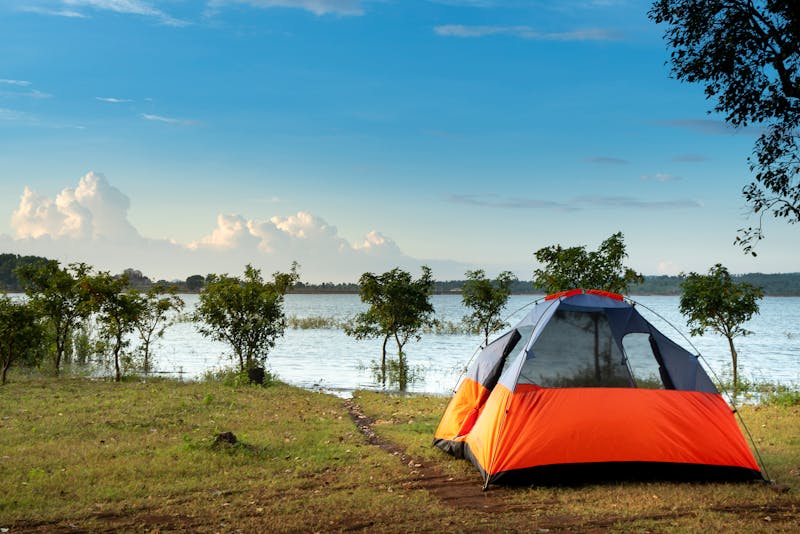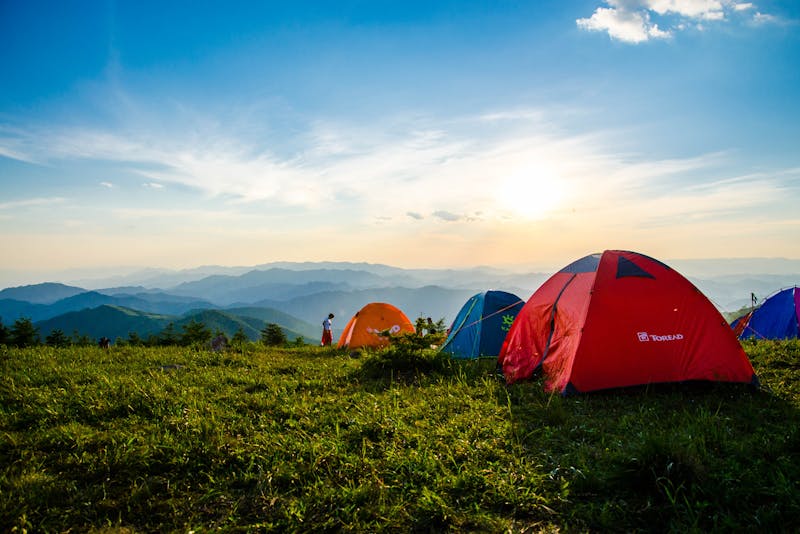- Choosing the best camping destination depends on your preferred environment and travel style, whether beach, mountain, forest, or lakeside.
- Beach camping offers coastal views and water activities, but requires awareness of tides, wind, and sun exposure.
- Mountain camping provides dramatic scenery and cool temperatures, but demands preparation for altitude, weather shifts, and wildlife.
- Forest camping delivers shade, natural tranquility, and rich wildlife, making insect protection and fire safety essential.
- Lakeside camping is ideal for relaxation and gentle outdoor activities like paddling, fishing, and picnicking.
- Understanding your comfort needs, activity preferences, and desired atmosphere helps you choose the perfect campsite.
Finding the perfect camping destination starts with knowing your travel style. Some travelers crave wide-open coastlines and ocean breezes. Others find peace in the mountains, surrounded by crisp air and dramatic peaks. Some campers prefer dense, shaded forests where wildlife and greenery create a refreshing escape, while others want serene lakesides that offer tranquility, water activities, and gentle scenery. No matter what environment speaks to you, choosing the right setting can make or break your outdoor experience.
Camping is not one-size-fits-all. The right destination depends on what type of adventure, comfort level, and natural surroundings you want to immerse yourself in. This guide will help you understand the best places to go camping based on your unique travel style so you can plan a trip that feels perfectly aligned with your idea of a great outdoor escape.
Beach Camping: Where Ocean Lovers Go for Sand, Sun, and Serenity

Beach camping is perfect for campers who thrive on fresh sea breezes, open horizons, and uninterrupted coastal views. Before choosing a beach campsite, consider the type of shoreline you enjoy most. Some travelers crave quiet coves, while others prefer long, expansive coasts with lots of space. You should also think about how much activity you want; some beach campsites offer surfing, kayaking, and coastal trails, while others are best for pure relaxation.
Beach camping also comes with unique considerations. Tides, weather, wind direction, and campsite regulations can significantly affect your experience. Many beach destinations require advance reservations, and some limit where you can set up your tent to protect natural shorelines or local wildlife. With some planning and the right location, beach camping can deliver some of the most breathtaking sunrises and starlit nights you can imagine.
Best Beach Camping Destinations
If the ocean calls to you, consider these scenic locations:
- National seashores with designated campgrounds
- Remote coastal parks that allow primitive beach camping
- Island destinations accessible by ferry
- Coastal trails with backpack-in beach sites
Each of these options offers a slightly different experience, whether you want isolation, accessibility, or activity-heavy surroundings.
Activities to Enjoy During Beach Camping
Beach camping offers various ways to enjoy the outdoors:
- Early morning walks along the shoreline
- Swimming, snorkeling, and freediving
- Paddleboarding or kayaking
- Beach volleyball or sandcastle building
- Sunset photography
Beach environments provide natural relaxation, but also plenty of ways to stay active and explore the coastline.
Safety Tips for Beach Campers
Consider these precautions during your trip:
- Check tide charts before setting up camp
- Secure tents against strong winds
- Store food properly to avoid attracting animals
- Bring sun protection and hydration
- Follow local beach regulations
Proper planning ensures your beach camping experience stays safe and enjoyable.
Mountain Camping: For Adventurers Who Love High Altitudes and Dramatic Views
Mountain camping appeals to travelers drawn to rugged landscapes, elevated trails, and cool temperatures. These campsites often offer some of the most rewarding views, as well as access to hiking routes, waterfalls, and dramatic rock formations. If you love challenging terrain, fresh mountain air, and panoramic scenery, mountain camping could be the perfect match for you.
Before choosing a mountain campsite, think about your comfort with altitude and physical activity. Mountain environments can be unpredictable. Temperatures may drop quickly at night, storms can roll in without warning, and wildlife encounters are more common. But with proper preparation, mountain camping can be one of the most exhilarating outdoor experiences, offering solitude and unforgettable landscapes.
Popular Mountain Camping Destinations
Mountain lovers can explore diverse regions such as:
- National parks with mountain trails and backcountry camping
- High-altitude campgrounds near famous peaks
- Mountain ridges with designated tent platforms
- Alpine lakes accessible by hike
These sites provide incredible views and unmatched opportunities for exploration.
What Makes Mountain Camping Unique?
Campers often choose mountain environments because of:
- Cooler temperatures ideal for summer trips
- Abundant hiking trails
- Opportunities to photograph wildlife and natural scenery
- Refreshing streams and waterfalls
- Rustic, peaceful surroundings
The combination of rugged terrain and serene beauty makes mountain camping a favorite for nature enthusiasts.
Tips for a Safe Mountain Camping Trip
Mountain camping requires extra preparation:
- Bring layered clothing for temperature changes
- Pack lightweight but durable gear
- Secure food and scented items away from wildlife
- Check weather forecasts regularly
- Prepare for steep trails and challenging terrain
With the right gear and planning, mountain camping becomes a rewarding adventure filled with beauty and excitement.
Forest Camping: Ideal for Shade, Wildlife, and Natural Calm
Forest camping is ideal for travelers who feel at home surrounded by trees, birds, and quiet natural environments. These destinations often provide shaded campsites, cool breezes, and abundant wildlife. Forests are perfect for travelers who seek solitude, greenery, and an immersive nature experience where you’re surrounded by the sights and sounds of the woods.
Before deciding where to go camping in a forest setting, think about your comfort level with insects, animals, and enclosed environments. Some campers love the feeling of being enveloped by towering trees, while others prefer more open landscapes. Forest camping tends to be peaceful and refreshing, especially during warm months when shade is essential.
Top Forest Camping Spots
Consider planning your camping trip in areas like:
- National forests with established campgrounds
- Woodland parks offering primitive sites
- Dense forest reserves with hiking and nature trails
- Mixed-wood campgrounds near rivers and creeks
Each destination offers a slightly different atmosphere depending on the type of forest and level of remoteness.
Highlights of Forest Camping
Forest environments are perfect for campers who enjoy:
- Birdwatching and wildlife photography
- Shaded trails and cool temperatures
- The calming sound of the wind moving through the trees
- Hammocking and nature meditation
- Exploring forest streams or small waterfalls
The peaceful rhythm of the forest makes it an ideal escape from busy city life.
Staying Safe in Forest Environments
A safe forest camping experience requires:
- Using insect repellent and proper clothing
- Storing food to avoid attracting wildlife
- Being aware of forest route markers
- Practicing fire safety, especially in dry seasons
- Keeping your campsite clean and secure
Respecting the forest ensures you can enjoy a quiet, healthy, and environmentally friendly trip.
Lakeside Camping: Peaceful Water Views and Relaxing Outdoor Activities

Lakeside camping is best for travelers who want a calm environment, easy outdoor activities, and beautiful reflective scenery. Many lakeside destinations offer a balance between tranquility and recreation, making them ideal for families, couples, and solo travelers. The gentle sound of water, scenic views, and accessible trails create an atmosphere that appeals to travelers who want less intensity and more relaxation.
When choosing a lakeside camping destination, consider the lake’s size, accessibility, and available activities. Some lakes are ideal for boating and fishing, while others offer quiet shorelines perfect for reading and unwinding. Lakeside weather is generally mild, but conditions can shift quickly, so it’s essential to prepare for sudden rain or temperature drops.
The Best Lakeside Camping Destinations
Many lakes offer unforgettable camping experiences, including:
- Large, recreational lakes with established campgrounds
- Small, quiet lakes ideal for peaceful retreats
- Mountain lakes with elevated views
- Lakes connected to hiking or biking trails
Different lakes offer different experiences, so choose one that matches your desired level of activity.
Why Travelers Love Lakeside Camping
This environment is perfect for activities such as:
- Morning or sunset paddling sessions
- Swimming and fishing
- Reading by the shore
- Picnicking near the water
- Wildlife viewing
Lakesides offer a soothing atmosphere that appeals to campers seeking relaxation and natural beauty.
Safety Guidelines for Lakeside Camping
Keep these tips in mind:
- Bring flotation gear for water activities
- Monitor changing water conditions
- Avoid swimming in unfamiliar depths
- Store gear properly to keep it dry
- Prepare for mosquitoes and moisture
With proper precautions, lakeside camping can be one of the most refreshing and enjoyable outdoor experiences.
How to Choose the Best Destination: Matching Your Travel Style to the Outdoors
Before deciding where to go camping based on your travel style, consider your comfort preferences, physical needs, and desired level of adventure. Some campers love intense activity and rugged terrain, while others want peaceful views and easy access to amenities. To choose your ideal destination, reflect on what matters most during your outdoor trip.
Factors to Consider When Choosing a Camping Environment
Think about the following factors when planning your camping experience:
- Desired scenery and atmosphere
- Accessibility and travel time
- Available activities
- Season and weather patterns
- Campsite amenities versus primitive camping
- Level of solitude versus social atmosphere
Understanding your preferences allows you to choose a destination that aligns with your ideal outdoor adventure.
Matching Campsite Features With Your Travel Style
Here’s a simple breakdown to help guide your decision:
- Beach camping for ocean lovers and sunset chasers
- Mountain camping for adventurers seeking elevation and challenge
- Forest camping for travelers who want calm, shade, and natural immersion
- Lakeside camping for campers who prefer gentle water scenery and easy activities
Your ideal environment depends on what type of experience you want to enjoy most.
Conclusion
Camping offers endless possibilities, whether you prefer rugged mountain peaks, peaceful lakesides, shaded forests, or sunny beaches. Understanding your travel style makes it easier to select a destination that aligns with your interests, comfort, and desired level of adventure. No matter where you go, camping provides a unique opportunity to reconnect with nature, unwind from modern life, and create memorable outdoor experiences.
Selecting the right environment ensures your camping trip feels rewarding, relaxing, and tailored just for you. With the information and tips in this guide, you’ll be ready to choose the ideal camping destination based on what inspires and excites you most.

